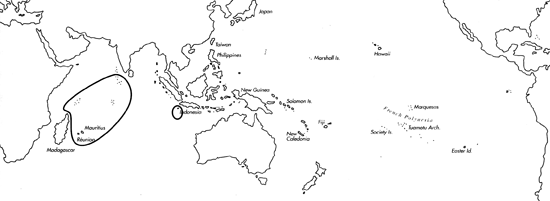Range: Mascarenes, Comores, Seychelles, Chagos and Maldives, probably also Sri Lanka; Christmas Is. and Cocos (Keeling) Is. (S. E. Indian Ocean).
Description: Medium-sized to large, moderately solid to solid; Maldive shells smaller. Last whorl ventricosely conical to conical; outline convex at adapical fourth, straight below, occasionally slightly concave centrally; shells from Christmas Is. and Cocos (Keeling) Is. narrower than those from other areas (Singleton, pers. comm., 1993). Siphonal fasciole prominent in larger shells. Shoulder broadly carinate to carinate. Spire low, of moderate height in Maldive specimens (Pl. 44, Fig. 11); outline usually sigmoid, sometimes nearly straight. Larval shell projecting, maximum diameter 0.7-0.8 mm. First 4-7 postnuclear whorls tuberculate, late whorls broadly carinate. Teleoconch sutural ramps almost flat, grading to deeply concave in late whorls, with 2 increasing to 4-9 spiral grooves that are often weak on latest ramps; prominent subsutural ridge as strong as or stronger than shoulder carina. Last whorl with weak to distinct, variably spaced spiral ribs and ribbons on basal fourth and with distinct to obsolete spiral striae to shoulder.
| Shell Morphometry | ||
|---|---|---|
| L | 42-84 mm | |
| RW | 0.23-0.73 g/mm | |
| (L 42-80 mm) | ||
| RD | 0.55-0.65 | |
| PMD | 0.82-0.91 | |
| RSH | 0.06-0.12 | |
| (typical form; 0.11- 0.14 Maldives) | ||
Ground colour white. Last whorl with variably broad, orangish to reddish or violet brown spiral bands usually leaving interrupted to solid narrow white bands centrally and at base. Spiral rows of blackish brown dots, spots, bars, and blotches from base to shoulder; number and arrangement of rows and markings within rows highly variable. Shells with immaculate last whorls almost completely overlaid with blending shades of orange to violet brown intergrade with shells that have their last whorls prominently mottled with white and black. In Maldives, last whorl lighter orange-pink. Siphonal fasciole white to pale orange. Larval whorls white. First 2-4 teleoconch sutural ramps immaculate white or cream; following ramps with light brown to black radial blotches usually extending over outer margin. Aperture white to bluish white.
Periostracum brown to olive-brown, rather thick, slightly translucent to opaque, with closely spaced fine axial and wrinkled spiral ridges.
Animal mottled light and dark brownish pink (Couacaud, pers. comm., 1988).
Habitat and Habits: In 10-30 m, inhabiting sand and rock substrata.
Discussion: C. barthelemyi is very similar to and perhaps conspecific with C. gauguini; it may also be confused with C. gubernator from the Mascarenes and Amirantes. For comparison, see the DISCUSSIONS of the latter species.

C. barthelemyi range map
This section contains verbatim reproductions of the accounts of 316 species of Conus from the Indo-Pacific region, from Manual of the Living Conidae, by Röckel, Korn and Kohn (1995). They are reproduced with the kind permission of the present publisher, Conchbooks.
All plates and figures referred to in the text are also in Röckel, Korn & Kohn, 1995. Manual of the Living Conidae Vol. 1: Indo-Pacific Region.
The range maps have been modified so that each species account has it own map, rather than one map that showed the ranges of several species in the original work. This was necessary because each species account is on a separate page on the website and not confined to the order of accounts in the book.